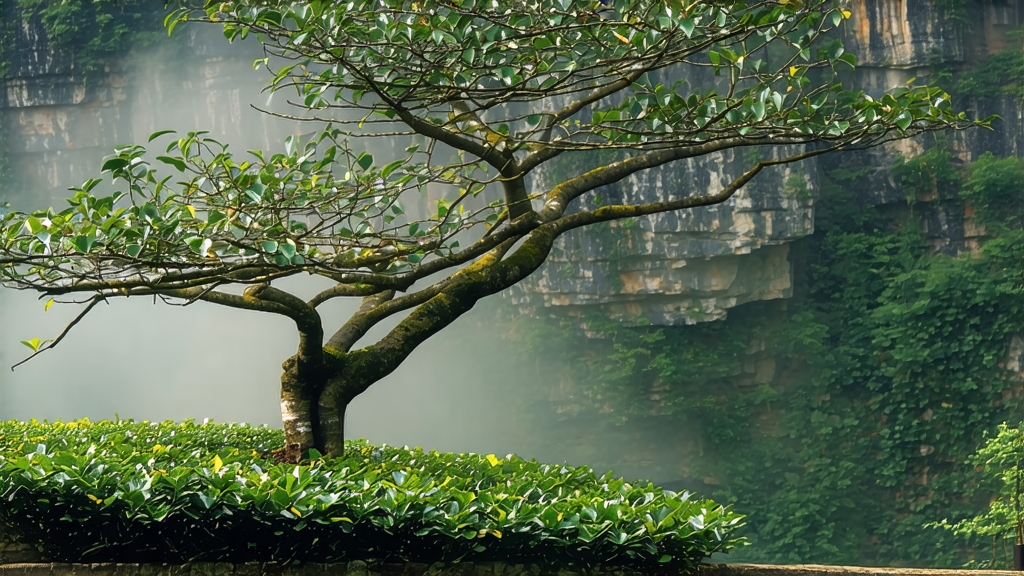
High in the mist-crowned Wuyi Mountains of northern Fujian, narrow bamboo rafts once carried tribute tea along the Nine-Bend Stream toward the imperial court. Among the rocky spires that gave those rafters vertigo, one cultivar took root so stubbornly that locals still call it “the stone-dwelling immortal”: Shui Xian, literally “Water Immortal” or “Narcissus.” First recorded in the Song dynasty, Shui Xian was originally a wild shrub discovered beside a mountain spring whose reflection, legend claims, looked like the Greek youth who fell in love with his own image. Monks transplanted the bush into cliff-side niches where mineral-rich run-off and temperature swings forced the plant to grow slowly, concentrating fragrant oils in leaves that were thicker than any other Fujian oolong. By the late Qing, merchants in the port of Xiamen were exporting “Bohea Narcissus” to London parlors, where its honeyed orchid aroma earned it the nickname “perfume of the Caradoc hills” among British botanists who had never seen Wuyi’s vertiginous terrain.
Today Shui Xian remains the most widely produced Wuyi rock tea (yancha), yet “widely” is misleading: true cliff-garden Shui Xian accounts for barely five percent of the 5,000 tons sold annually. The rest grows in the outer “half-rock” zone or on alluvial foothills, but even these lesser plots must obey strict geographical indication rules—any leaf pressed north of the 27°43′N line or below 200 m elevation cannot legally bear the name. Within the protected core zone, three micro-climates define stylistic substyles. “Zhengyan” (central cliff) gardens such as Niulan Keng and Huiyuan Keng yield fewer than 300 kg per mu, their leaves veined like pale jade after charcoal roasting. “Banyan” (semi-cliff) fields produce a rounder, peach-pit sweetness, while “Zhoucha” (river sand) terraces give a lighter, lily-like bouquet appreciated in southern Fujian’s coastal cities.
Crafting Shui Xian is a dialogue between fire and stone that stretches across four seasons. Picking begins in late April when three half-mature leaves still fold like a hawk’s claw. The pluck is spread on bamboo trays to wither under a gentle mountain breeze for two hours, then tossed in 1.5-meter diameter bamboo drums every twenty minutes through the night. This “cool bruising” fractures cell walls without rupturing them, initiating oxidation that hovers between 30–40 %—the widest band within the oolong family. At dawn the leaves are briefly pan-fired at 280 °C to arrest enzymes, after which they are rolled into tight, dark ribbons using a cotton cloth and a wooden plank, a technique known as “dragon kneading.” The half-finished maocha is then sorted by weight: only the heaviest 60 % will survive the final, most celebrated step—charcoal roasting.
Rock tea masters speak of “three roasts and three rests.” The first roast, called “walking fire,” lasts ninety seconds over a 120 °C ember pit made from local hardwood; the leaves lose 15 % moisture and absorb a whisper of smoke. They rest three days in earthen jars, then return to a 90 °C pit for “gathering fire,” where master roasters shuffle the leaves every twelve seconds using a horse-hair brush, listening for the crackle that signals residual water fleeing the midrib. After another week of dormancy the final “nourishing fire” drops to 70 °C and stretches twelve hours, caramelizing amino acids into the signature “rock rhyme” (yanyun)—a mineral finish that feels like licking wet slate. A tea that survives all three rounds without scorching can age for decades, its orchid scent deepening into dried longan and sandalwood.
To brew Shui Xian like a Wuyi cliff dweller, start with spring water whose TDS lies between 30–80 ppm; hard water dulls the mineral echo, while distilled water exaggerates tannins. Pre-heat a 120 ml Yixing teapot made from zhuni clay—its high iron content flatters the roasted bouquet. Measure 7 g of leaf, enough to blanket the bottom in a single loose layer. Flash-rinse for three seconds to wake the leaf, then infuse with 98 °C